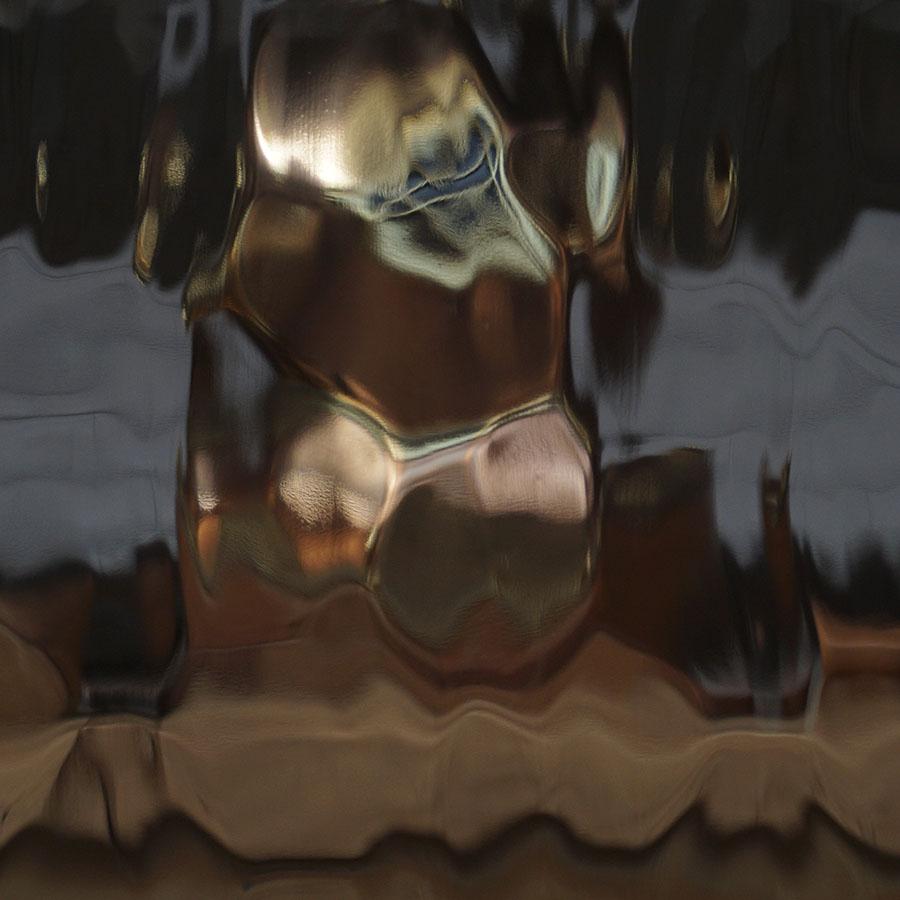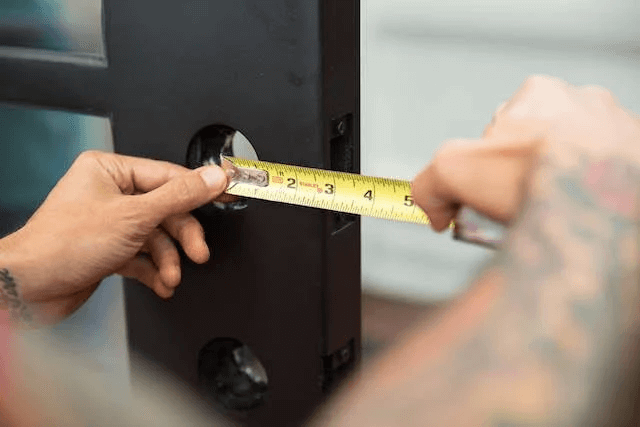
FINISH
- We use automotive paint to coat our doors.
- Galvanize spray is used to help provide greater protection against corrosion for the iron base. Primer and automotive paint is applied after the galvanizing spray process.
COATING THICKNESS
- Spray Primer Thickness - Around 180 microns
- Paint Color Thickness - Around 30 microns
- Clear Coat Thickness - Around 30 microns
Please be aware that we do not carry touch-up pens for the following colors at this time:
- Sunset Pink
- Palm Desert Sand
- Montecito Mint
- Angeles Green
- Casual Khaki
If your finish is damaged, you will need to match it at a local paint supplier.
- Because all of our products are hand made and painted, color may differ a little from the photo. This ensures each order is one of a kind.
Our newest glass option, Flemish Glass, is one that we feel is going to be a major hit. It's wavelike pattern throughout the entirety of the glass produces a privacy distortion without being visually loud. Light still transmits through the waves, and the lack of business still allows for a very clean look. Not impressed? Come take a peak at our showroom to see all we have to offer today.
Everything You Need to Know About Flemish Glass
Flemish glass is known for its beauty and durability, making it a popular choice for homeowners. But what else do you need to know about Flemish glass doors before making a purchase? Read our guide to find all the important information about Flemish glass doors for your home.
What Is Flemish Glass?
Flemish glass is a type of decorative glass most commonly used in iron doors. Using methods that date back centuries, artisans and manufacturers create beautiful mosaic patterns. It features a distinct ripple-like texture that offers privacy while still allowing light to pass through. paired with complementary materials, the unique texture also adds an aesthetic appeal to the door, creating an elaborate, upscale look and feel.
PINKYS Flemish glass doors feature some of the most attractive and timelessly classic architectural styles on the market today. Their delicate beauty and attractive patterns make them an elegant addition to any building's entrance or interior. In addition, a wide range of customization options is available when choosing Flemish glass doors for your home or business.
Flemish Hand Blown Glass: The Customers' Choice for Centuries
Flemish glass originated in today's Belgium and the Netherlands, hence its name. The first examples of Flemish glass date back to the 13th century, while it became particularly popular in the 15th and 16th centuries.
Flemish glass has always been characterized by its intricate designs and bright colors. Common motifs used in decoration included flowers, animals, and religious depictions. Many of the finest examples of Flemish glass can be found in churches and cathedrals throughout Europe.
The production of Flemish glass declined in the 17th century, but it experienced a revival in the 19th century. It is still prized by collectors for its beauty and history. Today, several companies produce Flemish glass in a traditional way.
How Are Flemish Glass Doors Produced Today
Modern Flemish glass is made through a mix of traditional handcrafting processes combined with contemporary manufacturing technology. It eliminates the seeds and bubbles while improving the structural properties of the finished product.
The process begins with leaded panes cut to shape from the original rolled sheets. Then, they are soldered together into large sheets, often numbered and stained in various colors and styles.
Flemish glass is created when two or more flat pieces are paired and subjected to increased pressure and temperature before being cooled down slowly. Thanks to this process, Flemish glass retains the look of hand-blown glass (minus the bubbles & seeds). It promotes the free flow of light while also becoming quite durable and capable of withstanding different weather conditions for a long time.
The Flemish glass doors are designed with appropriate holes and groves that allow pieces of glass to be inserted individually along the pane's perimeter.
Once installed, these individual pieces are trimmed around the edges with diamond tools or other specialized tools, depending on the desired pattern. The results are beautiful pieces of contemporary design that honor centuries' worth of Flemish glassworking traditions. One such example is PINKYS AIR 8 iron door model, favored by many customers.
Flemish Glass Applications
The unique properties of our Flemish glass make it a versatile and practical choice for design projects. It's an excellent option for any space requiring an opaque barrier that doesn't obstruct the light.
The patterned texture makes it suitable for a range of applications, including:
- front doors
- interior doors
- windows
- partitioning spaces
The Benefits of Using Flemish Glass in Your Iron Door
Flemish glass is the perfect addition to wrought iron doors, or any other type of doors. Not only it enhances the aesthetic of your entrance, but it also increases privacy and security levels.
- Aesthetics: Flemish glass is known for its unique and beautiful look. When used in a wrought iron door, the glass can add a strong touch of elegance and style.
- Strength: Flemish glass door is appreciated for strength. It is less likely to break than light types of glass, making it an excellent choice to complement an iron door.
- Energy efficiency: Another benefit of a PINKYS Flemish glass door is energy efficiency. The glass helps to maintain internal temperature levels throughout the seasons. This asset can reduce your energy bills.
- Safety: Flemish glass is also safer than some other types of glass. It's less likely to shatter, making it less likely to cause injury if the door breaks.
- Soundproofing: A Flemish glass door can also enhance the soundproofing of your house. The glass helps to block out noise from outside, making your home more peaceful and quiet.
- Privacy: PINKYS Flemish glass doors can be a good option if you are looking for privacy. The opaque nature of the glass will blur the view into your home.
- Ease of Maintenance: Flemish glass doors are also easy to clean and maintain. The smooth surface of the glass does not require much cleaning and is also resistant to scratches.
Can Flemish Glass be Tempered for Use on a Door?
A Flemish glass door offers a unique range of benefits, including superior resistance to impacts or heavy use. For many customers, its original assets are sufficient.
Nevertheless, the glass door's strength and resilience can be increased by up to four to five times through glass tempering, allowing you to make the most out of its versatility.
Flemish Glass Door's Privacy Rating
While a Flemish glass door doesn't block the view completely, it promotes privacy by distorting it. That way, it offers an excellent balance between seclusion and light transmission levels.
On a privacy rating scale from 1 to 9, a Flemish glass door typically starts at 3. The right rating for you depends on your needs. Opt for a clear Flemish glass door with a low privacy rating for maximum light flow, or go for increased opaqueness with higher rating numbers.
Customers often choose between Flemish glass, Rain glass, and Aquatex to enhance their door's privacy levels. From the practical side, all three options are quite similar. The key difference is in the look. Flemish glass door's advantage is that it offers an artisan, hand-blown glass appeal without the matching price tag.
How to Care For Your Flemish Glass Door
It is important to ensure the pristine look of your Flemish glass door for years to come. To do this, you should take proactive steps to protect it from the elements and daily wear and tear.
Start by periodically cleaning the glass with mild soap, warm water, and a soft cloth. That will help it retain its shine and prevent dirt build-up. You should also ensure that the frames are regularly waxed and polished to preserve their original color.
Always use subtle, appropriate cleansers in order to avoid any harm or damage done to your doors. This is particularly important in the case of wrought iron doors.
In Short
PINKYS Flemish glass doors offer strength, beauty, and timeless quality. Browse our page for a selection of Flemish glass doors in an array of stunning designs. You will find a perfect addition to enhance the elegant look of your home.
Type
Our dual pane tempered glass doors come with 1” T-Bar

Low E (Clear - completely see-through glass)
- Completely see-through glass design
- It has mirror glass affect depending on sun angle

Frost/Sandblast

Flemish

Rain

Aquatex

Ribbed

Ford Blue

Watercube

Wood

Diamond
JAMB
- Jamb is included and packaged separately from the door.
- Jamb is constructed with 12 gauge tube (above industry standard).

Polyurethane Foam Core is filled in the jamb for greater insulation.

Threshold: Steel threshold is included and it comes welded on the jamb.
In Swing Threshold:
- Thickness or height from the back interior side: 1 1/8”
- Thickness or height from the front exterior side: 1/2”
- Width or Depth: 6”

Out Swing Threshold:
- Thickness or height from the back interior side: 1 1/4”
- Thickness or height from the front exterior side: 1/2”
- Width or Depth: 6”

Brackets: Tabs come welded on jamb with pre drilled holes to allow for easy installation.

Hinges: Steel weld on bullet hinges with grease fittings come welded on jamb and door. Allows customers to comfortably open our doors, but yet feel that quality with each and every use. We use welded steel bullet hinge with copper crush washer instead of a ball bearing hinge because ball bearings are made out of stainless steel (hard material) and the hinges/doors are made out of steel (softer material) which over time causes the hinge to wear. With copper crush washers, the washer is the soft point and they are easily replaceable over time if needed.
If you choose to purchase your hardware/lockset from a third party vendor, please make sure to provide them with the following specifications to ensure that your desired lockset will be compatible with our doors.
| Bore hole size: | 2 1/8” |
| Back set: | 2 3/4” |
| Center to center: | 5 1/2” |
| Door thickness: | 2” |
- In stock single doors come with two pre drilled bore holes (one active lock needed) unless if otherwise specified.
- In stock double doors come with two pre drilled bore holes on each door (one active lock and one dummy lock needed) unless if otherwise specified.
- Locks purchased from PINKYS do not come installed on door upon delivery or shipment. The reason for this is that it may get damage during the delivery or shipment process. The installer will need to install the lock after the door installation is complete.
Bore Hole:

A bore hole is the doorknob hole that is drilled on the face of the door with a hole saw. The hole is drilled halfway through from each side. The hole saw is also used to drill the cross bore otherwise known as the latch hole. Both doorknob hole and latch holes come completed and drilled with every in stock order to help your installer install the lock at ease.

Center to Center:

The vertical distance measured between the center-points of the two bore holes. In other words, it is the measurement from the middle of the top bore hole to the middle of the bottom bore hole. This measurement is used to determine where a bore for the deadbolt is located above the bore for the latch. This information is important to help our customers purchase the correct compatible lock if you choose to purchase them from an outside hardware store. We have already done the homework for you by specifying the PINKYS locks that are compatible with your door if you choose to purchase the locks from PINKYS.
Back Set:

The backset is the distance from the edge of the door to the center of the 2-1/8” bore hole. The back set measurement is important to help our customers purchase the correct compatible lock with the correct latch size. We have already done the homework for you by specifying the PINKYS locks that are compatible with your door if you choose to purchase the locks from PINKYS. Our customers do not have to purchase the locks from PINKYS, you may purchase the locks from any local hardware store of your liking.

Door Thickness

REMOVABLE BUG SCREEN

SEE IT IN ACTION
IMPORTANT NOTE
the design of the door may alter or change to accommodate for the screen (most common example will be that of the designs with knuckles).
HOW OUR PRODUCTS ARE MEASURED
Our sizes are measured from outside of jamb to the outside of the jamb. For example, a 72” x 96” door listed on our website means that 72” is the width from outside to outside of jamb (not the actual width size of the door) and 96” is the height from outside of jamb to bottom of our built in steel threshold (not the actual height of the door).
We recommend the rough opening of the WIDTH to be 1/2” to 1” wider than the door size ordered to give the installer enough room to comfortably position the jamb into place and have enough room to make sure the jamb is leveled.
We recommend the rough opening of the HEIGHT to be 1/2” to 1” wider than the door size ordered to give the installer enough room to comfortably position the jamb into place and have enough room to make sure the jamb is leveled.
ROUGH OPENING
Our sizes are measured from outside of jamb to the outside of the jamb. For example, a 72” x 96” iron door listed on our website means that 72” is the width from outside to outside of jamb (not the actual width size of the door) and 96” is the height from outside of jamb to bottom of our built in threshold (not the actual height of the door)
We recommend the rough opening of the WIDTH to be 1/2” to 1” wider than the door size ordered to give the installer enough room to comfortably position the jamb into place and have enough room to make sure the jamb is leveled.
We recommend the rough opening of the HEIGHT to be 1/2” to 1” wider than the door size ordered to give the installer enough room to comfortably position the jamb into place and have enough room to make sure the jamb is leveled.
The Types of Door Swing
Double Doors
Facing the door, while standing on the exterior of your space, the right door will be your main active door. This door will have its hinges on the right interior side, and will swing towards the interior of your space, from left to right.
The left door, while standing on the exterior of your space, will be your inactive door. This door will have it’s hinges on the left interior side, and will be locked into the frame via flush bolts on both the top and bottom of the doors edge. Disengaging these bolts will allow your inactive door to swing towards the interior of your space, from right to left.

The right door, while standing on the exterior of your space, will be your inactive door. This door will have it’s hinges on the right interior side, and will be locked into the frame via flush bolts on both the top and bottom of the doors edge. Disengaging these bolts will allow your inactive door to swing towards the interior of your space, from left to right.

Facing the door, while standing on the exterior of your space, the right door will be your main active door. This door will have its hinges on the right exterior side, and will swing towards the exterior of your space, from left to right.
The left door, while standing on the exterior of your space, will be your inactive door. This door will have it’s hinges on the left exterior side, and will be locked into the frame via flush bolts on both the top and bottom of the doors edge. Disengaging these bolts will allow your inactive door to swing towards the exterior of your space, from right to left.

Facing the door, while standing on the exterior/outside of your space, the left door will be your main active door. This door will have it’s hinges on the left exterior side, and will swing towards the exterior of your space, from right to left.
The right door, while standing on the exterior of your space, will be your inactive door. This door will have its hinges on the right exterior side, and will be locked into the frame via flush bolts on both the top and bottom of the doors edge. Disengaging these bolts will allow your inactive door to swing towards the exterior of your space, from left to right.

What's included
Interior Knob Shape
| Round | Oval |
|
|
|
WHICH LOCK SET DO I NEED?
If you are ordering a single door - you only need (1) Active Lock.
If you are ordering a double door - you need (1) Active Lock & (1) Dummy Lock.

WHAT IS THE DIFFERENCE BETWEEN AN ACTIVE LOCK AND A DUMMY LOCK?
Single Doors
- Require an Active lock only.
Double Doors
- Require an Active lock, which is your locking hardware, to be installed on your active door or the door that is used most often.
- Require a Dummy lock, which has no mechanical latch mechanism, to be installed on the secondary door.
- Dummy locks do not function - the main purpose of a dummy lock is for aesthetic purposes only.
KW1 cylinder and keys included. Schlage hardware sold separately.
WHICH LOCK SET DO I NEED?
If you are ordering a single door - you only need (1) Active Lock.
If you are ordering a double door - you need (1) Active Lock & (1) Dummy Lock.

WHAT IS THE DIFFERENCE BETWEEN AN ACTIVE LOCK AND A DUMMY LOCK?
Single Doors
- Require an Active lock only.
Double Doors
- Require an Active lock, which is your locking hardware, to be installed on your active door or the door that is used most often.
- Require a Dummy lock, which has no mechanical latch mechanism, to be installed on the secondary door.
- Dummy locks do not function - the main purpose of a dummy lock is for aesthetic purposes only.
KW1 cylinder and keys included. Schlage hardware sold separately.

